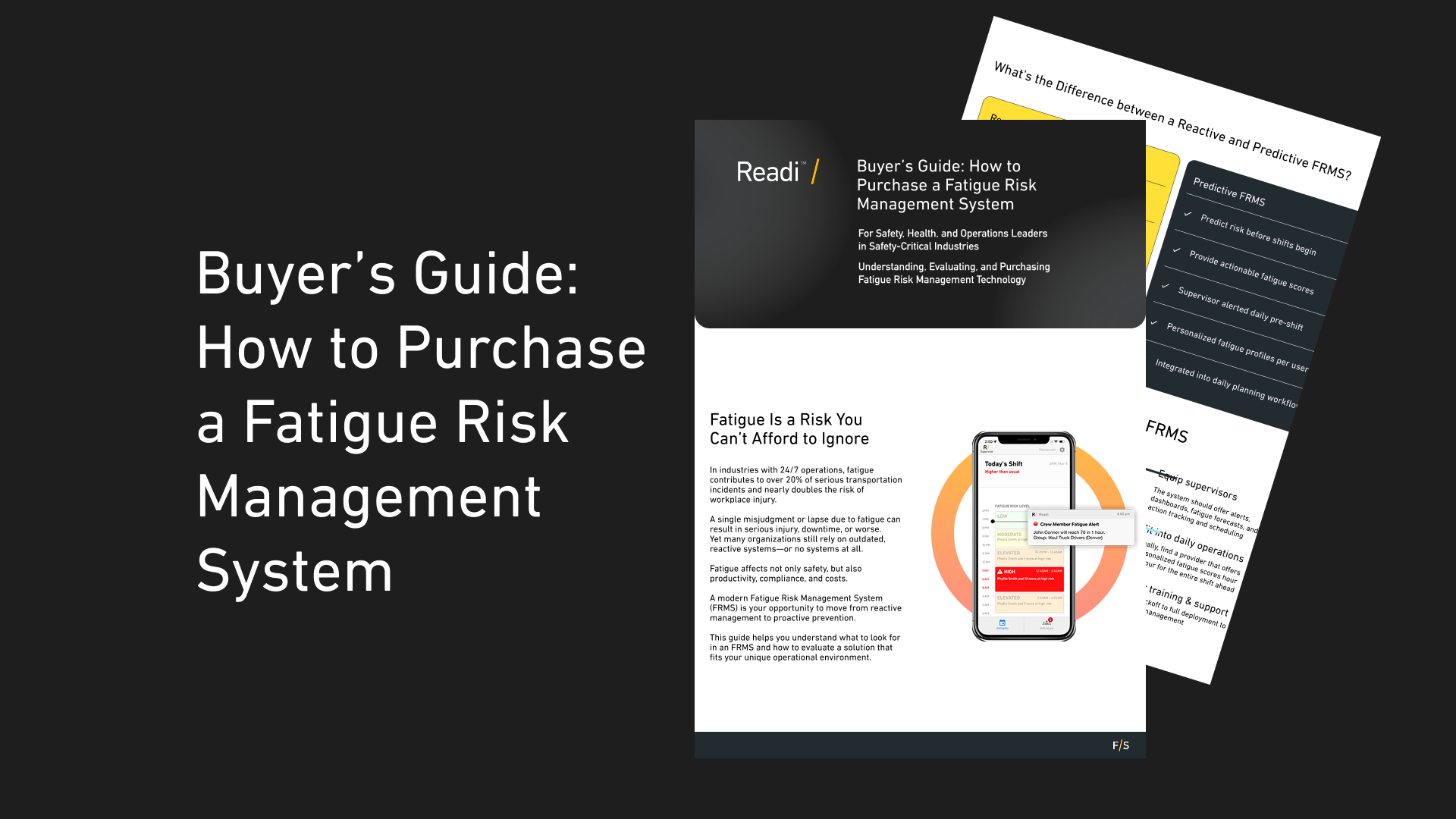In the transportation industry, many factors contribute to a high rate of fatigue among drivers. From shippers not providing adequate scheduling flexibility to unreasonable delivery demands by consignees, drivers can face difficulty receiving adequate sleep through all levels of the transport process. Drivers themselves are also responsible for the development of practices that enable them to get adequate sleep.
In this blog post, we’ll be looking at the risks associated with fatigue in the transportation industry, some of the common misconceptions about driving fatigued, and the fatigue management solutions that can be implemented to help solve this issue.
Risks Associated with Fatigue in Transportation
An abundance of evidence suggests that fatigue is a major risk within the transportation industry. The U.S. National Transportation Safety Board lists reducing fatigue-related accidents as one of their 2019-2020 10 most-wanted issue areas, and fatigue has been recorded as a factor in more than one in every five vehicle accidents resulting in injury or death. The U.S. National Safety Council finds that you are more than three times as likely to be in a car crash if you are fatigued.
When driving while fatigued, drivers experience several effects that all reduce their capacity for cognitive awareness. This includes longer reaction times and a decreased concentration, which when combined creates an opportunity for drivers to lose attention to the road and then to fail to adjust to changes in road conditions. Also impacted are judgement, memory, and vision. Besides yawning and the other commonly side effects, when driving, one of the major warning signs of fatigue includes having no memory of the last stretch of road travelled.
Responsibilities Across the Industry
When it comes to narrowing down the risks of fatigue in drivers, there’s a chain of responsibility throughout the industry, and it becomes the responsibility of everyone. While drivers hold responsibility as well, each part of the transportation industry needs to ensure that they’re allowing drivers adequate time to rest, providing the means to do so if necessary, and allowing for flexibility in the event that drivers do need additional time to rest. Based on multiple available government recommendations, the following parties are responsible for the following aspects of fatigue mitigation:
Shippers
Shippers with a lack of flexible pick up hours could be found responsible for unsafe driving habits among drivers. This comes from the fact that drivers could be encouraged to drive long distances without stops in order to make an unreasonable pick-up time or location. A financial incentive to make a pick-up may take priority over safety for some drivers, and by not avoiding this situation, a shipper could be found responsible for encouraging unsafe driving habits.
Heavy Vehicle Operators
Heavy vehicle operators are responsible for planning schedules and routes for drivers that allow for adequate rest periods avoid risk factors. Failure to account for scheduled rest periods while planning routes or providing inadequate training to drivers could leave heavy vehicle operators responsible for the actions of those drivers if they ultimately make poor decisions because of external pressures. Also important is providing vehicles that are adequately ergonomic, and which are built for the transportation need.
Drivers
Drivers are also responsible for planning routes and schedules which will allow them to receive adequate rest and sleep. Drivers are also responsible to make use of fatigue risk management practices. As with any job, drivers are also responsible for making sure that they’re fit for duty. This means avoiding dangerous medications, drugs, and alcohol, and allowing themselves enough time for sleep during their off hours. Maintaining a secondary job that doesn’t allow for adequate sleep periods leaves drivers responsible for their choice to work and not rest.
Consignees
As with shippers, consignees are responsible to allow for adequate flexibility of scheduling to allow for drivers to rest and not feel pressured to maintain dangerous schedules. Unreasonable demands on the part of a consignee leaves them responsible for the actions of drivers feeling monetarily pressured to act without caution.
The responsibilities of each of these parties mean that eliminating fatigue within the transportation industry requires a group effort. A true fatigue risk management plan requires accounting for all aspects of the industry, and can’t be solely the responsibility of the driver. This also means long-term planning, as opposed to the short-term solutions that many people often think of when it comes to eliminating fatigue while driving, which we’ll look at next.
What Can Be Done to Combat Fatigue in the Transportation Industry
It’s a common misconception that by turning up the music, drinking coffee, and cranking up the air conditioning in a vehicle, that drivers can stay alert while fatigued. While taking these measures can feel like a relief in the short term, the only real solution for fatigue is sleep.
The best method for avoiding fatigue while driving includes planning for breaks and driving strategically during the periods of highest awareness. Due to the natural circadian cycle, the periods of lowest awareness occur between 1:00 and 3:00 p.m. and between midnight and 6:00 a.m. By making sure to rest or sleep during these periods if possible, drivers are able to fight against the naturally delayed responses of the body. Regular breaks are another important way to avoid fatigue while driving. Ideally, drivers should not be on the road for more than two hours at a time and should plan for regular rest stops.
When driving for long periods of time, it’s especially important for drivers to recognize their own symptoms of fatigue. Because it’s not always possible for drivers to fully recognize their own fatigue, we recommend the use of additional aids to help recognize and prevent fatigue while driving.
Finding Solutions
The best way to understand and prevent fatigue is to anticipate it. By wearing the Fatigue Science ReadiWatch while sleeping, drivers are not only provided with insights into how rested they actually are, but with predictive data of future fatigue. With this knowledge in hand, it’s possible to better plan trips around periods of low awareness, and to instead rest during those times when they would be most fatigued.
The side effects of fatigue are often compared to driving under the influence of alcohol, and the statistics available for vehicle accidents backs up the danger from fatigue on the roads. By proactively avoiding fatigue, drivers can remove much of the risk associated with their profession. With data in hand, drivers can plan nap periods, get more effective rest, and experience better state of wellbeing.
While the entire industry plays a part in helping to remove fatigue from the road, only drivers can understand their own cognitive awareness. Tools like Readi help to empower drivers and heavy vehicle operators alike with the information that they need to make better decisions on the road. To learn more about how Readi can provide insights to drivers and their organizations, talk to an expert at Fatigue Science about scheduling a demo.
Further Reading:
- Reduce Fatigue-Related Accidents
National Transportation Safety Board (US, 2016) - Drowsy Driving is Impaired Driving
National Safety Council - Prevalence of Motor Vehicle Crashes Involving Drowsy Drivers, United States, 2009-2013
AAA Foundation for Traffic Safety (2014) - Dead Tired at the Wheel
Société de l’Assurance Automobile Quebec (2018) - Driver Fatigue – Fatigue Management Guide
Société de l’Assurance Automobile Quebec (2011) - Driver Fatigue: A Survey of Long Distance Heavy Vehicle Drivers in Australia
National Transport Commission




